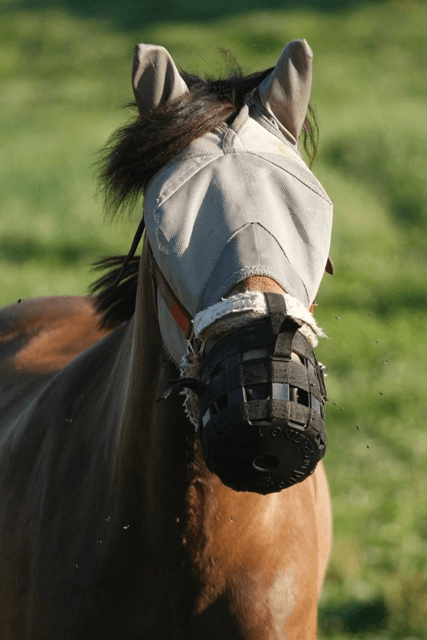Changing our Nutritional Approach to the “Easy Keeper”
By Rachael S. Levine, DVM of Henderson Veterinary Associates
What is an “easy keeper”?
Traditionally, horses have been divided into two categories in regards to how much they need to eat in order to maintain their weight and body condition: “hard keepers” and “easy keepers”. Sensibly, “easy keepers” do not require much in the way of feed to maintain good weight and condition, while “hard keepers” require more careful feeding and monitoring. Our feelings on this is starting to shift. It is now recognized that “easy keeping” horses come with their own, inherent, challenges for husbandry, most notoriously in preventing excess weight and body condition.
How to tell if your horse is too fat:
When I examine a horse for weight I am most concerned with their body condition score (BCS), rather than a specific number on the weight tape. This is in part because the ideal number is different depending on the size (and sometimes breed) of your horse. If I tell you I have a 1000 pound horse, this does not say much. If my 1000 pound horse is a Thoroughbred you would not be terribly worried, however what if my 1000 pound horse is a Percheron? What if it is a large pony? The size of your horse is also important in determining if their condition is appropriate. In our practice, we use the Henneke body condition scale. It is a scale out of nine, where 1-3 are too slender, 4-5 is ideal and 6-9 to over conditioned. In this article, we are going to discuss the over conditioned horses (those of a BCS 6-9).
The most commonly evaluated points of the horse are:
1.) How easily, or not, I can palpate (or feel) the ribs. As a visual, take your hand and make a fist. If you run the index finger of your other hand over the tops of your knuckles, you can feel (and see) how easy it is to feel the bumps. If it is this easy to feel the ribs of your horse (or dog, cat or other pet), they are probably too thin. If you lay your hand flat and flip it palm side up and run the index finger of your other hand over the bumps of the underside of your knuckles you will notice that you can feel the underlying bone, how-ever you have to push fairly hard. This is like the ribs of an over conditioned animal. You can feel the bumps of their ribs, however you have to press fairly firmly and there is flesh between your finger and their ribs. An approximate example of ideal condition is if you are to lay your hand flat, palm down, on a flat surface. Run the index finger of your other hand over the top of your knuckles. You can feel the individual bumps, however there is flesh appreciable between them and slightly over them. This is a good start to judging if the ribs of your horse are appropriately appreciable.
2.) Fat pads. Over conditioned horses tend to put fat pads in characteristic places. Most commonly, these are seen in the crest of the neck, behind the shoulder blade and around the tail head. Large, firm fat pads in these areas are especially associated with insulin resistance.
Equine Metabolism and Conditions
It is becoming commonly recognized that the metabolism of your horse affects their ability to appropriately use the calories they take in from eating. In younger horses, often younger than 15 years but they can be older as well, we most commonly see Equine Metabolic Syndrome (EMS). These are young, easy keeping horses and they tend to put their fat in the characteristic places mentioned above. We sometimes joke that they are “air ferns”, as they seem to need nothing more than air to not just survive but prosper. In older horses, we more commonly see Cushing’s Syndrome. Cushing’s syndrome is caused by an overproduction (or over administration) of steroids. In the horse, it is most commonly associated with a benign tumor of the pituitary (hence the name Pars Pituitary Intermedia Dysfunction (PPID)). The most common signs of Cushing’s is hirsutism (inappropriate hair coat) that is characterized by long, sometimes curly, hair that is of-ten does not shed appropriately. These horses may be “easy keepers”, or eventually, they are often horses who used to be easy keepers, that suddenly seem to lose condition and be harder to maintain.
Horses that suffer from EMS and/or PPID often have insulin resistance (IR). This is a metabolic condition, in some ways like diabetes mellitus in people. In all mammals, insulin acts to decrease blood sugar by asking cells to absorb it out of the blood. In the case of insulin resistance, the cells ignore the insulin and these horses end up with very high blood insulin and blood sugar levels. We are starting to make connections be-tween these resulting high sugar levels and risk of laminitis (founder). It is also important to know that horses that suffer from EMS are more likely to develop PPID at a younger age.
What about your horse?
In our practice, the most common cause of laminits, or founder, is due to a metabolic reason! In addition to an increased risk of laminitis, we also see horses that have more trouble with arthritis, decreased endurance and other issues associated with obesity.
It’s mostly in the blood!
When we see your horse is tending towards over conditioning, we often recommend bloodwork. Over-weight horses can be started on a diet and exercise program, however having baseline bloodwork is important. It allows us to know where we start, and more effectively monitor how your horse does as we correct his condition. In older, PPID-suspect horses, bloodwork is essential to monitor hormone levels and ensure that our treatment is working appropriately.
What we look at:
The first series is a full health screen with an insulin:glucose ratio and an ACTH added This lets us evaluate your horse for signs of infection, inflammation; liver and kidney values; electrolytes and several other things. The insulin and glucose is important if your horse is overweight as it lets us determine if insulin resistance is present, and if so to what degree. The ACTH is specific for looking for PPID. ACTH is a hormone associated specifically with the pituitary and is responsible for over production of steroid in the body in horses with PPID. Elevated ACTH levels correlate with PPID, indicate if treatment is warranted, and if the treatment is working
Any follow up will include insulin:glucose rations, ACTH if needed and any recheck of other values as needed.
The new Oral Sugar Test: this is a new test that gives us a more sensitive method to detect horses that are suspected to have IR but have a good body condition score and may have had normal fasting insulin levels in the past. It is a simple test, with increased accuracy that will help us to find horses before issues can develop.
There is a study currently being conducted at the University of Minnesota looking into the genetics of EMS and IR that needs horses. You can visit their website for more information about the study, the types of horses they need and information on EMS: www.cvm.umn.edu/equinegenetics/ems/
So your horse is known to be over conditioned (with or without EMS or PPID, what do we do about it?
1. Know what you’re feeding. The first step is to determine how many calories your horse needs to be eating per day and evaluate their ration. Remember, calories come from pasture, hay, grain, supplements, treats, etc. Correct the number of calories you are feeding to your horse if necessary.
2. Get out and ride! If you can’t or don’t ride, simply increasing the exercise is important. Longeing, free longing, chasing your horse around his/her field, taking them for walks; anything is better than nothing!
3. Grain really is optional for some horses! Hay should be the bulk of your horse’s diet (the majority of what s/he eats). Not all horses need grain, and as you know the amount they require can be very variable. There is an interesting article in Equus February 2011 (issue 401) pp 14-15. It discussed the need for fiber in your horses diet.
4. Know what’s in your hay! You can judge if a hay is moldy, dusty or musty by look and smell but remember: sugar and other nutrients are not green! We can not tell if your hay is going to meet your horse’s micronutrient requirements or if it has a lot of sugars (non-structural carbohydrates) by site, smell or taste! Hay analysis is the best way to know what your horse is getting. This will also let you determine how many calories you are feeding your horse in hay per day. There are several labs that offer the service around the country and it is very affordable (around $30-$40).
5. What if your horse shouldn’t have grain, but you feel bad or he/she pitches a fit if none is given during feeding time? Remember, regular grain is designed to be fed in multiple pounds per day rations. If you are not feeding enough, the grain is probably only giving your horse sugars and not much else. Feed companies have started to make lower calorie foods (keep in mind they may still be high in sugar, and careful tag reading and discussion with the company is often needed to determine if it is the right food for your horse!). Additionally, ration balancer pellets (also called vitamin/mineral supplement pellets) are available from most national feed companies. Higher in necessary micronutrients, lower in sugars with variable protein, they are designed to be in smaller quantities but still meet the needs of these horses. Some companies also control the sugars (nonstructural carbohydrates) for IR horses as well.
6. Pasture, and pasture associated laminitis. Remember, grass is trying to grow tall and reproduce, therefore it spends all day in the sun making sugar, then all night converting sugar to fiber and starch while it grows taller. Grass is highest in sugars in the afternoon through the middle of the night. Grass in full sun is higher in sugar than grass in shade. Grass that is short is higher in sugar than grass that is tall (more fiber and it naturally shades itself) and finally, stressed grass is highest in sugar of all (it is making sugar but not growing. This is especially true of grass in the spring and fall, when the days are warm but the nights are cold. In horses that are insulin resistant, they often can not handle the insult of increased sugar, even just from their pasture. For horses that are unable to tolerate this sugar, the best thing you can do is limit their access. This can be accomplished by limiting grass turn out and putting your horse on a dry lot. While on the dry lot, typically, tested hay is fed to know the amount of sugar that is being fed. Some horses can also be turned out with grazing muzzles on. These may feel like torture, however the idea is that the horse must work more for every bite of grass and it slows consumption. If you are turning your horse out (with or without the muzzle) on grass, also consider timing when they are out carefully. It is best to have them out early in the morning (dawn or just before) until late morning. This is the time the grass is naturally less in sugar.
7. Treats. We all like to give our horses treats, however most traditional treats (especially apples and carrots) are high in sugars (nonstructural carbohydrates). Some of the horses that do not tolerate these sugars are found to greatly enjoy having peanuts as a treat instead. These are higher in protein and lower in sugars, and are sometimes less risky for the IR individuals.
8. Medications to help.
In the case of EMS horses, we can sometimes add a thyroid supplement to the treatment plan of your horse to help increase their metabolism. Most horses with EMS do not get hypothyroidism (low production of thyroid hormone) as was previously thought. The goal of the thyroid supplement is to increase metabolism of the horse to help them lose weight. Horses that receive a thyroid supplement are often able to be weaned off of it slowly once the desired weight and condition goals are met. In a few cases, some horses may need to be maintained on low doses for long periods to control their signs.
In the case of PPID horses, they must be treated with Pergolide in order to control their disease. This medication acts in the pituitary to control the amount of ACTH that is released. Once started on Pergolide, we typically monitor the ACTH levels of your horse to make sure they are adequately controlled by the dose he/she is receiving. Even if the ACTH levels go back to normal, your horse will still need to receive Pergolide for the rest of his/her life to continue to control the ACTH levels.
The things to remember:
- Over condition is not good for your horse and can put them at risk for a variety of disease processes, especially laminitis
- The body condition of your horse affects their metabolism
- The metabolic condition of your horse can influence how easy it is to help them lose weight
- Controlling condition through diet and exercise is best
- Medications can be added if your horse needs help or suffers from PPID
About the Author
Dr. Rachael S. Levine is originally from the northwest corner of Connecticut and grew up owning and riding horses. She was an active member in her local Pony Club throughout high school, both competing and teaching riding lessons. She received her Bachelor of Science degree from Elizabethtown College. Following this, she attended the Tufts University Cummings School of Veterinary Medicine in Massachusetts. Her veterinary interests include reproduction and lameness. In her free time, she enjoys riding her horse Ciao, reading and baking.















